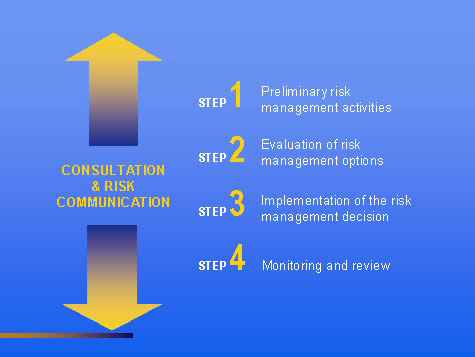



Campylobacter in Poultry Risk Management Strategy 2007-2010
By the New Zealand Food safety Authority.1. Introduction
The New Zealand Food Safety Authority’s mission is to protect consumers and enhance New Zealand’s position as a trusted supplier of food. NZFSA recognises the high rates of human campylobacteriosis in New Zealand and the contribution that food, and poultry especially, make to this unacceptable health burden.
It has now been scientifically established that poultry meat is a primary exposure pathway in New Zealand. NZFSA has developed a comprehensive risk management strategy aimed at achieving sustainable reduction in Campylobacter levels in chicken meat through scientifically robust interventions at appropriate points in the food chain, and adopting a multi-pronged approach to Campylobacter risk reduction.
The Campylobacter risk management strategy includes:
- developing targeted controls throughout the food chain
- focusing on hazard -based controls in the medium term
- focusing on risk-based controls in the longer term
- determining the proportionality of poultry compared with other transmission pathways
- intensifying monitoring programmes to establish current baselines and show changes over time
- promoting good hygienic practice (GHP) by consumers
- collaborating with the international science community on all aspects of risk assessment and risk management
While the ideal is for risk-based controls, given the scale of the public health problem, overseas experience, and the evolving science, hazard based interventions will be required as an urgent response to reduce the public's exposure to Campylobacter.
This document describes the NZFSA Campylobacter in NZ poultry risk management strategy for the next three years and, specifically, spells out the work programme that will be achieved n the next twelve months. We will regularly report on progress on the NZFSA website.
2. Objectives of the Campylobacter risk management strategy
The objectives of the Campylobacter risk management strategy are as follows:
- To reduce the incidence of foodborne human campylobacteriosis
- To better quantify the proportion of foodborne cases attributable to poultry
- To understand the relative value of different interventions throughout the food chain in reducing risks to human health
- To make well-informed risk management decisions on appropriate control measures and their implementation
- To design and implement an ongoing monitoring and review programme to assess the effectiveness of risk management decisions
3. Background
What is Campylobacter?
Campylobacter is a bacterial organism that causes the gastrointestinal disease campylobacteriosis when it lodges in the walls of a person’s intestine. In particular, there are two species of Campylobacter that cause human illness and these are Campylobacter jejuni and Campylobacter coli.
Human campylobacteriosis
Illness usually strikes within 2 – 5 days of exposure but can take up to 10 days. Symptoms include general muscle pain, stomach cramps, nausea, headache or fever followed by sudden watery diarrhoea that may contain blood. Most people feel ill for about a week. During the illness, and up to a fortnight afterwards, bacteria are shed from the gut and can survive on hands and moist surfaces for up to an hour.
The relationship between exposure and human illness is by no means clear. The dose-response relationship of Campylobacter and human illness is not well established. The role of immunity is not clear either. Nevertheless it can be assumed that the smaller the exposure, the more likely a reduction in the incidence of human illness will be.
The incidence of human campylobacteriosis in New Zealand is unacceptably high. Much research is being undertaken to identify solutions capable of reducing these high rates.
Pathways
There are many pathways for Campylobacter to reach the human population (especially in New Zealand) and knowing the relative importance of each of these is obviously very important when prioritizing areas for control. Once a significant pathway has been identified, its relative significance must be established using attribution techniques. Available scientific information shows that poultry meat is the main food pathway.
Knowledge of the cost and the feasibility of application of measures to reduce risks is an important input to risk management. In this regard, a risk model is a very useful tool that assists in the decision making process by organizing existing knowledge on potential interventions, identifying data gaps and providing estimates of outputs.
Ongoing comprehensive research
The New Zealand Food Safety Authority’s (NZFSA) research programme on Campylobacter has been comprehensive and longstanding over more than ten years, including involvement of the Ministry of Health and the Institute of Environmental Science and Research (ESR). It is now scientifically established that poultry is a primary pathway for the disease inNew Zealand as it is in other countries. However, it must be noted that as far as current knowledge indicates, poultry accounts for just over half of the identifiable infections. Therefore whatever is done to address the problem in poultry, will impact on only a proportion of the reported cases in New Zealand.
Risk management Framework
The NZFSA risk management framework (RMF) provides a systematic process whereby knowledge on risk and evaluation of other factors relevant to control of hazards are used to choose and implement regulatory standards or other measures. The four generic steps involved in applying a RMF are shown in Figure 1. Effective risk management incorporates appropriate risk communication and stakeholder representation at all steps.
 |
| Figure 1: Components making up the risk management framework |
Campylobacter risk management strategy working group
NZFSA has a dedicated Campylobacter risk management strategy working group to coordinate all work relating to Campylobacter in poultry, and update the risk management strategy. The working group represents expertise from several of the business groups within NZFSA.
Risk communication
Communicating the risks inherent in food is an important part of the Campylobacter risk management strategy. NZFSA will communicate all aspects of the Campylobacter risk management strategy, results of work undertaken and develop communication strategies to assist the successful and effective implementation of Campylobacter reduction initiatives that result from this work.
Further Reading
|
|
- To view the full article, please click here. |
September 2007











